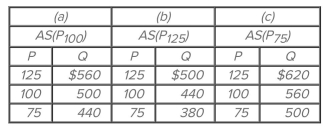Multiple Choice
 Suppose the full employment level of real output (Q) for a hypothetical economy is $500, the price level (P) initially is 100, and prices and wages are flexible both upward and downward. Refer to the
Suppose the full employment level of real output (Q) for a hypothetical economy is $500, the price level (P) initially is 100, and prices and wages are flexible both upward and downward. Refer to the
Accompanying short-run aggregate supply schedules. In the long run, a fall in the price level from
100 to 75 will
A) decrease real output from $500 to $440.
B) increase real output from $500 to $620.
C) change the aggregate supply schedule from (a) to (c) and produce an equilibrium level of real output of $500.
D) change the aggregate supply schedule from (a) to (b) and produce an equilibrium level of real output of $500.
Correct Answer:

Verified
Correct Answer:
Verified
Q215: One implication of the Laffer Curve in
Q216: Which of the following is a tenet
Q217: Supply-side economists recommend higher marginal tax rates
Q218: Since the Great Recession of 2007-2009<br>A) the
Q219: In the cost-push model of inflation, increases
Q221: How do supply-side economists see reducing taxes
Q222: Based on the long-run Phillips Curve, any
Q223: <img src="https://d2lvgg3v3hfg70.cloudfront.net/TB8601/.jpg" alt=" Refer
Q224: <img src="https://d2lvgg3v3hfg70.cloudfront.net/TB8601/.jpg" alt=" Refer to the
Q225: <img src="https://d2lvgg3v3hfg70.cloudfront.net/TB8601/.jpg" alt=" Refer